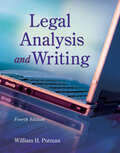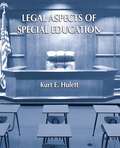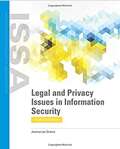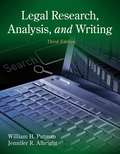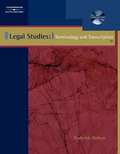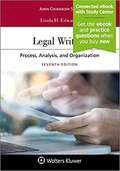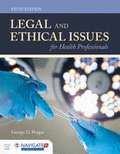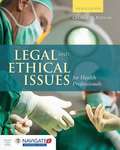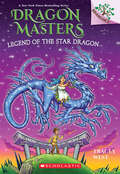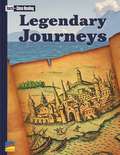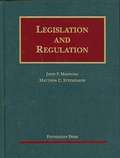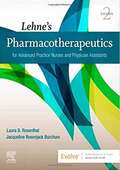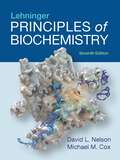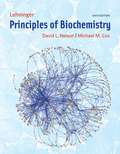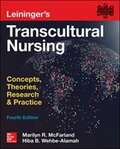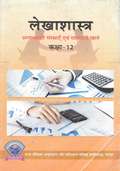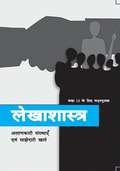- Table View
- List View
Legacy of Freedom: A History of the United States
by Glenn M. Linden Dean C. Brink Richard H. HuntingtonThe history of the earliest people in the Americas begins in the distant past, before written records were kept. In order to discover the ways in which these early people lived, historians must turn to sources other than written records. Much of the prehistory of the Americas--that is, the time before the invention of writing--lies buried beneath thousands of years of human development. As a result, the artifacts and fossils of early people must be unearthed and carefully examined. Archaeologists, anthropologists, and historians can then gradually piece together the life-styles of early people in the Americas.
Legal Analysis and Writing
by William H. PutmanLEGAL ANALYSIS AND WRITING, 4TH EDITION helps readers analyze statutes and cases and draft supporting legal memoranda. In addition to the fundamentals of good writing, legal or otherwise, the book illustrates how paralegals analyze and brief cases, identify key facts and legal issues, and apply case law and counteranalysis to legal matters, and more. Going beyond mere explanations, the book shows readers how to apply concepts to hypothetical situations, draft legal memoranda and correspondence, and scrutinize legal citations and Web research, to develop a thorough understanding of the analytical and writing responsibilities paralegals undertake. Legal Analysis and Writing, 4th Edition is a robust resource for any paralegal writing course and includes a host of available supplemental tools designed to enhance learning while simplifying instructor preparation.
Legal Aspects Of Special Education
by Kurt E. HulettFor every course in Special Education Law and Education Law, or as a perfect supplement to any Educational Administration course, Legal Aspects of Special Education was written by a practitioner to help teachers, administrators, and advocates understand special education law in everyday language- without excessive legalese or extraneous case law. Different in many ways from other special education law texts on the market, all of the elements of this text are intended to help its students obtain the most critical information about special education law and how it is applied in the real world. Some unique features include: a fascinating opening interview and then epilogue with Joe Ballard, a pioneer of the IDEA movement; a discussion of Response-to-Intervention (RTI) and the implication of IDEA 2004 for school districts; and a discussion of the history of special education and its link to the Civil Rights Movement. Additionally, the book provides case studies and application questions, critical thinking questions, the most current information on the laws including No Child Left Behind and the Individuals with Disabilities Education Act of 2004, and a discussion of major trends changing the laws, including that of autism.
Legal Aspects of Corporate Management and Finance
by Jethro K. Lieberman Don Mayer Daniel M. Warner George J. SiedelMayer, Warner, Siedel and Lieberman's Legal Aspects of Corporate Management and Finance is an up-to-date textbook that covers key legal issues relating to corporate management and finance. The text is organized to permit instructors to tailor the materials to their particular approach. The authors take special care to engage students by relating law to everyday events with their clear, concise and readable style.
Legal Aspects of Marketing and Sales
by Jethro K. Lieberman Don Mayer Daniel M. Warner George J. SiedelMayer, Warner, Siedel and Lieberman's Legal Aspects of Marketing and Sales is an up-to-date textbook that covers legal issues that students who will work in marketing or with marketing managers must understand. The text is organized to permit instructors to tailor the materials to their particular approach. The authors take special care to engage students by relating law to everyday events with their clear, concise and readable style.
Legal Issues in Information Security
by Joanna Lyn GramaThoroughly revised and updated to address the many changes in this evolving field, the third edition of Legal and Privacy Issues in Information Security addresses the complex relationship between the law and the practice of information security. <p><p>Information systems security and legal compliance are required to protect critical governmental and corporate infrastructure, intellectual property created by individuals and organizations alike, and information that individuals believe should be protected from unreasonable intrusion. Organizations must build numerous information security and privacy responses into their daily operations to protect the business itself, fully meet legal requirements, and to meet the expectations of employees and customers. Instructor Materials for Legal Issues in Information Security include: PowerPoint Lecture Slides Instructor's Guide Sample Course Syllabus Quiz & Exam Questions Case Scenarios/Handouts <p><p>New to the third Edition: • Includes discussions of amendments in several relevant federal and state laws and regulations since 2011 • Reviews relevant court decisions that have come to light since the publication of the first edition • Includes numerous information security data breaches highlighting new vulnerabilities
Legal Office: Concepts and Procedures
by Robert CumminsThis textbook-workbook is divided into three parts with seventeen chapters to provide the legal office assistant student with a logical frame of reference in the study of the basic concepts of the law.
Legal Research, Analysis, And Writing
by William H. Putman Jennifer R. AlbrightComprehensive yet easy to understand, the third edition of LEGAL RESEARCH, ANALYSIS, AND WRITING teaches the fundamentals in a hands-on, step-by-step format that is designed to build confidence. With coverage of key topics such as research analytical principles, legal research, legal analysis, and legal writing, this popular book covers the information readers need to know in order to find, access, apply, and analyze legal materials. Numerous hypotheticals, examples, and exercises clarify material and give readers additional opportunities for practice. In addition, the third edition includes the most up-to-date information in the field, with special attention given to electronic research programs such as WestlawNext, LexisNexis interface, Shepard's online, and Westlaw's KeyCite.
Legal Studies: Terminology and Transcription (5th Edition)
by Wanda Roderick-BoltonThis text provides a basic understanding of legal vocabulary for administrative personnel in a legal office. Over 900 terms commonly used in the legal profession are included. Users will learn to define the terms and use them in a legal context. Keyboarding practice from printed copy will reinforce learning the correct spelling and proper use of each term.
Legal Writing And Analysis (Aspen Coursebook)
by Linda Holdeman EdwardsThis streamlined text offers a straightforward guide to developing legal writing and analysis skills for beginning legal writers. Legal Writing and Analysis, Fifth Edition by Linda Edwards, leads students logically through reading and analyzing the law, writing the discussion of a legal question, and writing office memos, letters, and briefs. The text includes chapters on citation form, writing style, professionalism, and oral argument. <P><P> The book features special focus on forms of legal reasoning (rules, analogies, policies, principles, customs, inferences, and narrative) complete with examples and exercises. It teaches students to recognize rule structures and use them to organize their document. <P><P> New to the Fifth Edition: Streamlined chapters and exercises Updated citation materials covering current editions of both citation manuals Product page featuring more material on professional letters and accessible coverage and use of legal theory <P><P>Professors and students will benefit from: Contextual learning, including important legal method material Superior treatment of how to organize a legal discussion Clear, ample coverage of legal reasoning Practice-oriented approach Numerous examples and short exercises for formative assessment Strong coverage of professional responsibility
Legal Writing: Process, Analysis, And Organization (Aspen Coursebook)
by Linda H. EdwardsBuy a new version of this textbook and receive access to the Connected eBook with Study Center on CasebookConnect, including: lifetime access to the online ebook with highlight, annotation, and search capabilities; practice questions from your favorite study aids; an outline tool and other helpful resources. Connected eBooks provide what you need most to be successful in your law school classes. Learn more about Connected eBooks Legal Writing: Process, Analysis, and Organization, Seventh Edition by the 2017 Burton Award recipient and renowned author, Linda Edwards, is the only legal writing text that uses a process approach, presenting writing as a logical sequence of steps. Streamlined to meet the needs of today’s students, the Seventh Edition uses adult learning theory concepts and a “flipped classroom” approach to add even greater focus and efficiency to classroom and study time. Key Features: New Chapter (4) on working with statutes. Updated chapter on citation Improved coverage of brief-writing Streamlined chapter on letter writing to better meet the need of a first-year course. Modern process approach, with streamlined content for better absorption by students Clear and informal language Helpful appendices offering sample of office memos, sample letters, and appellate briefs.
Legal and Ethical Issues for Health Professionals
by George D. PozgarLegal and Ethical Issues for Health Professionals, Fifth Edition is a concise and practical guide to legal and ethical dilemmas facing healthcare professionals in the real-world today. Thoroughly updated and featuring new case studies, this dynamic text will help students to better understand the issues they will face on the job and the implications in the legal arena. With contemporary topics, real-world examples, and accessible language, this comprehensive text offers students an applied perspective and the opportunity to develop critical thinking skills. Legal and Ethical Issues for Health Professionals provides an effective transition from the classroom to the reality of a clinical environment.
Legal and Ethical Issues for Health Professionals
by George PozgarLegal and Ethical Issues for Health Professionals, Fourth Edition is a concise and practical guide to legal and ethical dilemmas facing healthcare professionals in the real-world today. Thoroughly updated and featuring new case studies, this dynamic text will help students to better understand the issues they will face on the job and the implications in the legal arena. With contemporary topics, real-world examples, and accessible language, this comprehensive text offers students an applied perspective and the opportunity to develop critical thinking skills. Legal and Ethical Issues for Health Professionals provides an effective transition from the classroom to the reality of a clinical environment.
Legend of the Star Dragon: A Branches Book (Dragon Masters)
by Tracey WestThe legendary Star Dragon must battle the powerful Shadow Dragon in the latest action-packed installment of this New York Times bestselling series!Pick a book. Grow a Reader!This series is part of Scholastic's early chapter book line, Branches, aimed at newly independent readers. With easy-to-read text, high-interest content, fast-paced plots, and illustrations on every page, these books will boost reading confidence and stamina. Branches books help readers grow!Drake and the rest of the Dragon Masters are one step closer to stopping the Shadow Dragon from blanketing the world with its sky-shadow. They have the Star Flute! Now they just need to summon the Star Dragon. But first they must figure out how to play the flute. They will need to work fast! Can the Star Dragon help them save the world?With engaging black-and-white artwork on every page, kids won't be able to put down this action-packed adventure!
Legislation and Regulation
by John F. Manning Matthew C. StephensonThis casebook is specifically designed for a first-year class on Legislation Regulation, and provides a proven, ready-to-use set of materials for schools or instructors interested in introducing such a class to their 1L curriculum.
Lehne's Pharmacotherapeutics for Advanced Practice Nurses and Physician Assistants
by Laura Rosenthal Jacqueline BurchumLehne's Pharmacotherapeutics for Advanced Practice Nurses and Physician Assistants, 2nd Editionbuilds on the same foundation of clearly explained, up-to-date, and clinically current content as the trusted Lehne undergraduate text, while focusing on the information that advanced practice nurses and Physician Assistants specifically need for safe and effective prescribing. <p><p>Three introductory chapters provide foundational content for new prescribers in the areas of prescriptive authority, rational drug selection, prescription writing, and promoting positive outcomes of drug therapy. Core drug chapters are focused on the drugs that prescribers will most commonly see in clinical practice. A sharp focus is also placed on pharmacotherapeutic decision-making, with Black Box Warnings and new bulleted Key Prescribing Considerations features. <p><p>The second edition features completely new chapters on Genetic and Genomic Considerations, Muscarinic Antagonists and Immunomodulators, and updated content throughout. It’s everything advanced practice nursing and Physician Assistant students need to be safe and effective prescribers!
Lehninger Principles of Biochemistry
by David L. Nelson Michael M. CoxLehninger Principles of Biochemistry is #1 bestseller for the introductory biochemistry course because it brings clarity and coherence to an often unwieldy discipline, offering a thoroughly updated survey of biochemistry's enduring principles, definitive discoveries, and groundbreaking new advances with each edition. This new Seventh Edition maintains the qualities that have distinguished the text since Albert Lehninger's original edition--clear writing, careful explanations of difficult concepts, helpful problem-solving support, and insightful communication of contemporary biochemistry's core ideas, new techniques, and pivotal discoveries. Again, David Nelson and Michael Cox introduce students to an extraordinary amount of exciting new findings without an overwhelming amount of extra discussion or detail.
Lehninger Principles of Biochemistry (Sixth Edition)
by David L. Nelson Michael M. CoxPrinciples of Biochemistry has put defining principles into practice, guiding students through a coherent introduction to the essentials of biochemistry without overwhelming them. The new edition brings this remarkable text into a new era. Like its predecessors, Lehninger Principles of Biochemistry, Sixth Edition strikes a careful balance of current science and enduring concepts, incorporating a tremendous amount of new findings, but only those that help illustrate biochemistry’s foundational principles. With this edition, students will encounter new information emerging from high throughput DNA sequencing, x-ray crystallography, and the manipulation of genes and gene expression, and other techniques. In addition, students will see how contemporary biochemistry has shifted away from exploring metabolic pathways in isolation to focusing on interactions among pathways. They will also get an updated understanding of the relevance of biochemistry to the study of human disease (especially diabetes) as well as the important role of evolutionary theory in biochemical research.
Leininger's Transcultural Nursing: Concepts, Theories, Research and Practice
by Marilyn R. McFarland Hiba B. Wehbe-AlamahThis book offers theoretical and practical guidance about the provision of client-focused care by integrating cultural values, beliefs, and lifeways into an individualized plan of care. <p><p>This acclaimed resource presents a global comparative perspective about Western and non-Western cultures and examines the potential future directions for transcultural nursing with insights into rural and urban cultures in the United States including the culture of homeless mothers and children. The book covers important topics such as transcultural nursing, research, and healthcare in Kenya, Southeast Asia, Haiti, Syria, and Taiwan, as well as translational research, globalization, conflict resolution, mental health considerations, Ayurvedic medicine, genetics and genomics in healthcare, integration of care and caring, and an overview of transcultural history, concepts, and principles. <p><p>Reflecting the work of experts and scholars in the discipline, the Fourth Edition includes twenty-five new chapters. There are also major updates to the Theory of Culture Care Diversity and Universality, Ethnonursing Research Method, Sunrise Enabler, and other enablers.
Leisure Studies: Themes and Perspectives
by Shaun BestWhat is the place of leisure in societies where people complain of 'over-work'? How do personal freedom and choice relate to the inequalities of class, gender, disability and ethnicity?<P><P> This critical introduction to the field offers a systematic account of the meaning and structure of leisure today. <P> The book:<P> * situates the student in the field<P> * provides a comprehensive account of the leading approaches to leisure<P> * explores the influence of class, race, gender, ethnicity, disability and age<P> * discusses to role of the sate<P> * examines leisure in the context of changing work relationships<P> * locates leisure in the debate around globalization<P> In short, this is an indispensable, one-stop guide to understanding leisure.
Lekhashastra Alaabhkari Sansthayen Evam Sajhedaree Khate class 12 - S.C.E.R.T Raipur - Chhattisgarh Board: लेखाशास्त्र अलाभकारी संस्थाएँ एवं साझेदारी खाते कक्षा 12 - एस.सी.ई.आर.टी. रायपुर - छत्तीसगढ़ बोर्ड
by Raipur C. G. Rajya Shaikshik Anusandhan Aur Prashikshan Parishadलेखाशास्त्र अलाभकारी संस्थाएँ एवं साझेदारी खाते कक्षा 12 वीं का राज्य शैक्षिक अनुसंधान और प्रशिक्षण परिषद् छत्तीसगढ़ रायपुर ने पुस्तक हिंदी भाषा में प्रकाशित किया गया है, इस पाठपुस्तक में पांच अध्याय दिये गये है, जिसमे हर अध्याय के विवरण कि व्याख्या कि गई है ।
Lekhashastra Alabhakari Sansthayen Evam Sajhedaree Khate class 12 - NCERT - 23: लेखाशास्त्र अलाभकारी संस्थाएँ एवं साझेदारी खाते १२वीं कक्षा - एनसीईआरटी - २३
by Rashtriy Shaikshik Anusandhan Aur Prashikshan Parishadलेखाशास्त्र अलाभकारी संस्थाएँ एवं साझेदारी खाते 12 वीं कक्षा का राष्ट्रीय शैक्षिक अनुसंधान और प्रशिक्षण परिषद् ने पुस्तक हिंदी भाषा में प्रकाशित किया गया है, इस पाठपुस्तक में चार अध्याय दिये गये है, जिसमे हर अध्याय के विवरण कि व्याख्या कि गई है। इस पाठपुस्तक में साझेदारी लेखांकन-आधारभूत अवधारणाएँ, साझेदारी फर्म का पुनर्गठनः साझेदार का प्रवेश, साझेदारी फर्म का पुनर्गठन–साझेदार की सेवानिवृत्ति/मृत्यु और साझेदारी फर्म का विघटन आदी जैसे विषयों पर चर्चा की गई है।
Lekhashastra Company Khate Evam Vittiya Vivaranon Ka Vishleshan class 12 - NCERT - 23: लेखाशास्त्र कंपनी खाते एवं वित्तीय विवरणों का विश्लेषण १२वीं कक्षा - एनसीईआरटी - २३
by Rashtriy Shaikshik Anusandhan Aur Prashikshan Parishadलेखाशास्त्र कंपनी खाते एवं वित्तीय विवरणों का विश्लेषण 12 वीं कक्षा का राष्ट्रीय शैक्षिक अनुसंधान और प्रशिक्षण परिषद् ने पुस्तक हिंदी भाषा में प्रकाशित किया गया है, इस पाठपुस्तक में छह अध्याय दिये गये है, जिसमे हर अध्याय के विवरण कि व्याख्या कि गई है। पाठपुस्तक में वर्ष 2011 में लागू की गयी कंपनी अधिनियम 1956 की संशोधित अनुसूची VI (वर्तमान में कंपनी अधिनियम 2013 की अनुसूची III) के अनुसार भारतीय कंपनियों द्वारा तैयार किए गए वित्तीय विवरणों के प्रारूप और प्रदर्शन में बदलाव किया गया है जिसमें तुलन-पत्र और लाभ व हानि विवरण के विशेष संदर्भ में दर्शायी जाने वाली परिसंपत्तियों और देयताओं के सुनिश्चित वर्गीकरण एवं नामावली में परिवर्तन प्रमुख हैं।

